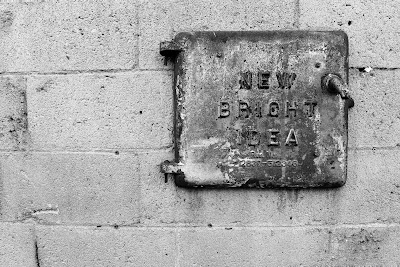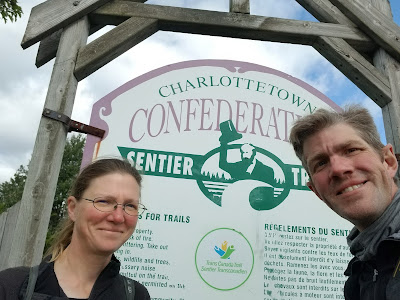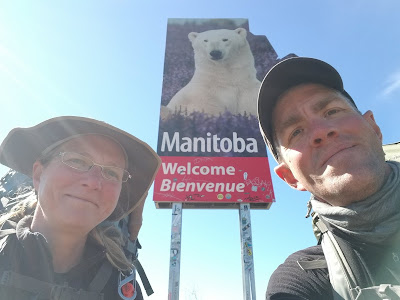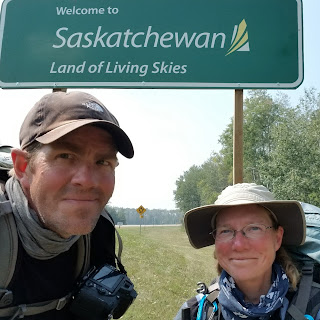“Spur” Decision : Exploring Montreal’s Canal-de-Lachine
I went to bed last night, in a thick duvet in a near soundproof room in downtown Montreal believing that the trekking year had come to an end. Despite the delays brought on by the second and third waves of Covid in 19 leading to 3 rounds of quarantine, we had successfully trekked more than 3000km across the provinces of Manitoba, Saskatchewan and the majority of Quebec! Arriving into Montreal we reached another milestone – having now also completed 10,000 km of trekking in Canada over more than 365 days on the Trans Canada Trail while also giving over 100 presentations to groups across the nation! It was time to rest… or so I had hoped.
Sean however is not one to rest, not one who was looking forward to stopping for the season, and definitely one who lives with the frustrations rather than the celebrations of the moment – and so was awake at 6 am…ready to hike. His lone concession was a willingness to have a breakfast of chocolate crepes before heading out.
He had been awake most of the night, frustrated by our reception at the TCT the day before and not wanting to end on such a note had spent the evening and morning striving to find ways to keep going. Certainly the weather was still warm enough to trek. According to our drafted plans it would take us just 5 short days to venture to Mont Tremblant northward up the beautiful P’tit train du Nord. The route and amenities along it was such that we would not need to carry our camping gear (now picked up from the post office) nor carry extra food. It could be undertaken, but to be honest I also felt that we were done. Besides in 7 days I was due to return to work. If we kept hiking I would literally walk off the trail and return to a computer with no downtime between this hiking year, work and our return to the train in 2022.
As a result, following a spirited ‘debate’, fuelled by French chocolate and strong cappuccino, ‘we’ reached a different decision. Rather than continuing on trekking the 200 km of the TCT around Montreal to Mont-Temblant simply to satisfy the urge to keep going we would stick to our original plan and head back to Ontario tomorrow. The concession being that we would return to the Sentier Transcanadien and hike a spur of the trail today.
This is how, with our extra day off in Montreal we did not relax, we did not simply take in the history, or culture as planned. Instead we hiked. Thankfully while Sean is stubborn and driven, he is not unreasonable. Of the number of possible routes in Montreal that the TCT follows he chose the one spur that would take us toward French food and one of my favourite places in the city – Le Marche Atwater, or the Atwater Market.
Following breakfast we returned to our hotel room picking up the cell phone, the Garmin tracker and camera and set out to wander through downtown Montreal and the trail. As now seems traditional for us we were drawn to the old quarter of Montreal, where the weight of history in this beautiful city was most evident. In Montreal, much like Europe, it seems that every corner in this city, holds a piece of history, notes some essential part of national culture, or memorializes a great achievement undertaken by Canadians. Some of the most unique places can even be found down the narrow alleys where Victorian lanterns still hang and snatches of days past still stand out.
As we walked at random around Old Montreal I was captivated by the stray corners of history that we found. Unassuming plaques on the sides of buildings, statues to people long past, and inscriptions that tell a story – if you take the time on the busy city streets to stop and learn.
Similarly wandering we found amazing local art and unique statues sitting in corners of streets and alleyways. Each making me wish that we had the time to explore more or the ability to learn more about them.
When setting out this morning we had the hope of being able to visit the iconic Notre Dame Basilica, Unfortunately the Basilica, much like Province House in PEI, and Parliament in Ottawa was under construction with much of its beautiful façade covered. After years of hiking around Europe and Canada I have come to believe that this generation will never get to see these buildings owing to their constant and necessary renovations. Instead our view of these great monuments will be one as seen through scaffolding and Tevek tarp. Given the situation throughout Old Montreal with so much construction, so much scaffolding, and so many Covid closures we did not spend much time here.
Instead we continued on revisiting the Historic
Old Port and walking along the shoreline.
En route we took the opportunity to learn about a large grey building we had seen a number of times on our visits to Montreal but knew nothing about. As it turns out, this imposing corner building with its distinctive architecture and clock tower is known as the Commissioner’s Building. According to what we learned, it stands as a prime example of a Second Empire style of building and starting in 1876 served as the corporate headquarters of the Harbour Commission which from 1830 onward managed the Port of Montreal. Commission was charged with developing the regional quays, sheds, and infrastructure of the port supporting industrial growth and the region’s development. Much like the railways across Canada ports are one of those essential parts of many of our cities whose essential and historical role in developing the nation many don’t explore.
Continuing on we passed the massive grain silos built in 1905 at Quai de la Pointe du Moulin a Vent and the Redpath silos on the skyline that we had briefly seen yesterday. As we left the cobblestone walkways of the Old Port district we returned to the Trans Canada Trail trekking down a spur which would take us west.
As we have discovered in many of Canada’s larger cities the Trans Canada Trail is not a straight line or a single route. In Montreal the TCT has a number of side trails beyond the main pathway which follows the shoreline east before turning north. Here there are paths which go from downtown Montreal north to Laval, a 22 km section in the community of Mascouche / Lac-Samson, the 25 km Senterier Mirable in Saint-Augustin, and a 12 km walkway along the historical Canal-de-Lachine.
Having crossed part of it yesterday when we arrived into Montreal, we rejoined Park’s Canada’s Historic Lachine Canal and followed the walkways which paralleled both sides of it. The Lachine Canal, which along with the industry and maritime traffic that has passed through this waterway reflect over three centuries of European history in the region. As far back as 1670, soon after French settlers arrived, Rev. Francois de Salignac de La Mothe Fenelon proposed the digging of a canal as a solution to navigating the nearby rapids blocking the St. Lawrence River from the Great Lakes. At his urging the French Colonial Government began attempting to bypass the treacherous Lachine Rapids, in 1689. For a number of reasons however it wasn't until 130 years later that a group of businessman, led by the Scottish immigrant John Redpath (of Redpath Sugar) were successful in their efforts. The result was a navigable waterway which connects the Old Port of Montreal to Lake Saint-Louis, running through the boroughs of Lachine, Lasalle, and Sud-Ouest.
The opening of this canal in 1825 created a route for heading to the Great Lakes and by 1851 it would be the first link in a chain of canals – Montreal to Kingston around regional rapids, Welland Canal around Niagara Falls, and the Sault Ste. Marie Canal joining Lakes Huron and Superior - that was a 2100km industrial and commercial supply chain stretching from the Atlantic Ocean all the way to Lake Superior and the heart of North America. With the construction of these networks marine traffic dramatically increased, manufacturers established themselves along the canal, and Montreal quickly became the nation's first industrial centre. As maritime traffic increased shops opened alongside the canal facilitating the processing, sale, and transport of products ranging from grain, wood, lumber, coal, and petroleum. So essential was the canal that it would be enlarged in 1848 and then again in 1884 making Montreal into and its canal one the most vital parts in the Canada’s development rivalled in North America by only New York City for the volume of trade.
Between 1850 and 1950 the Lachine canal was the centre of some of the largest industrial sectors in Canada. Known throughout the nineteenth century as the ‘Smoky Valley’ it would be the location that nearly 800 companies would manufacture and do business and where thousands of Canadians would be employed. In response to the rapid industrial growth the city of Montreal would also experience a huge amount of development and growth. During this period the population of the region would rise from 58,000 to over a million transforming the city into a centre filled with working class burrows and neighbourhoods dominated by the chimneys of the manufacturing district. By the early twentieth century fifteen thousand ships per year ventured through the canal system being navigated by Canaler vessels designed to maneuver the Great Lakes and regional lock systems. Throughout the decades these ships would grow in size and payload capability as the canals were expanded. These vessels were not designed for ocean conditions yet despite this many of them would be used as convoy vessels during both World Wars.
The launch of the Saint Lawrence Seaway in 1959 led to the closing of the canal in 1970 to shipping and industry and given to Parks Canada in 1978 who embarked upon an ambitious revitalization program to preserve the Canal’s history, and allow for the development of the region. The Lachine Canal Historical Site was subsequently been reopened for recreational vessels in 2002 allowing them to cross the 14 metre change in elevation between the port of Montreal and Lachine. In addition to the restoration of the waterway, there are a number of cycling trails and walkways, including the Trans Canada Trail, which trace alongside the banks of the canal system. The TCT section and spur is approximately 12 km each way, meaning that today back on the national pathway we would ultimately walk between 25 and 30 km including Old Montreal, the Old Port and along the canal on our final day in Quebec.
The urban pathway we followed today runs the length of the canal and is clearly well used by residents and cyclists. According to Michael Haynes, author of a number of TCT guidebooks, these trails were once noted as one of the most beautiful urban multipurpose paths in the world. The Lachine pathways are actually composed of a number of trails on both sides of the canal waterway, including a paved surface which is part of the Route Verte for cyclists and a crushed gravel walkway. In addition there are benches along the route as well as a huge number of information panels along the way detailing the history of the region and the transformation of the canal from being a centre of shipping and Montreal’s industrial heart, to a recreational corridor and Park’s Canada Historical site.
Along much of this former industrialized district including the Old Port and Lachine Canal here in Montreal, which like Vancouver and Toronto have been developed transforming former factories into a popular district filled with green spaces, parks, upscale condos, houses, restaurants, museums and businesses. The result being that much of today’s trek was along a pathway edged by modernized glass condo buildings and futuristic office buildings. Our route took us past the Peel Basin, under local bridges, and through parks filled with tables complete with inlaid chess boards.
Given our
later departure this morning and wandering around the historic districts in
downtown Montreal we arrived at Le Marche Atwater around noon. Located only a few steps off the Canal de
Lachine and the Trans Canada Trail, Marche Atwater is both one of our favourite
places to visit in Montreal. The popular
market is housed in an absolutely beautiful Art-Deco brick building designed by
Ludger Lemieux and is topped by a clock tower.
Around the site and along the canal are grass parks with benches and picnic tables which are ideal for brief breaks or picnics! The Atwater Market was named after a nearby avenue which in turn was named after Edwin Atwater, a nineteenth century businessman and city councillor. Inside the Market is a essentially a long hallway filled with shops and stalls selling a plethora of fresh produce, cheeses, meats, oils, mustard, chocolates and (best of all) pastries !
While here we picked up a few edibles for my parents and grandmother to be sent for the holidays, but our primary goal was my favourite place – the Boulangerie Première Moisson !
After snacking on chocolates and croissants we continued west past packing and cardboard factories as well as more condos and houses developed from repurposed historical brickworks and industrial buildings. As the afternoon passed we sat on one of the benches along the trail, enjoyed a warm coffee and another chocolatine from Boulangerie Première Moisson. We soon arrived at Pont Gauron and decided that it was time to turn back and return to Montreal’s downtown. While ultimately our day was neither long nor eventful, it was nonetheless both a very beautiful and peaceful way to end the year! Today there had been no real goal (beyond pastries) in setting out and no planned destination. It had just been us enjoying a quiet walk on the Trans Canada Trail.
In the evening we were fortunate to be able to once again meet up with Daniel Baylis for dinner to thank him, to celebrate the publication of his newest book – Wild Birds – and to chat about the past three years on the trail. We also, admittedly, vented a little about our frustrations and missed opportunities. In response and in his usual polite and patient manner Daniel again offered us sage advice. A global traveller himself, he reminded us to enjoy the moment, be honest in our blogs and posts, and to strive to find the lesson in every experience. Above all however he also told us that even while trekking to promote something we passionately believe in that we had to remember to still hike our own hike. As always Daniel is grounding, insightful and inspiring. We would leave dinner feeling better about the past year and returned to our room to pack for the train ride back to Ontario. In the morning we will leave Quebec 525 km short of our goal of completing the province but having ventured far further in 2021 than we believed possible following all the delays and 45 days of quarantine in the spring.
More than a month ago, in early October we made a decision. With Edmonton Alberta, only 300 km away but out of reach due to rising Covid numbers and the provincial state of Emergency, we planned to come back to Quebec to complete as much of the 1000km in the province as we were able to before winter arrived. Despite our exhaustion – which at that point was bone deep – our plan required that we not only keep trekking, and that everything went perfectly, but that we would also have an improbable run of great weather. While there have been a few unexpected bumps on the road here, and while the weather as of Nov. 10th is 14 degrees and feels more like late summer than early winter giving us the chance to continue – after pushing to trek 620 km in 22 days we know now we are both exhausted. I suspect we could push another 250 km to Mont-Tremblant or Grand Remous in the next 4 or 5 days. However the pace we have set in Quebec has already been hard and fast, the distance covered huge for the time we have spent on the trail, our gear is done for, and the weight loss for the year on both of us has become dramatic. It is time to stop for 2021.
Besides what’s the rush? Above all Quebec has reminded us of something essential in this trek. Between the wondrous landscapes, tremendous food, amazing history and culture, and the kindness of its people, Quebec has shown us that even though we have goals in front of us on the Pacific and Arctic coasts there is no need to rush to get there. It is the journey not the destination. Whether on the trail or off, trekking along pathways, walking highways or dealing with the obstacles en route the last three years have already flown by. Why try to make things go faster than they already are?
We had a Plan and a schedule, but (let’s be honest) no one can maintain a set schedule when there are fresh pastries, kind people, amazing landscapes, and great trails along the route. Besides who wants to race through all the amazing things Canada has to offer? The truth is that a month ago we had a schedule, but the wonder and awe of Canada “got in the way”.
In 2019 we concluded our trek in Riviere du Loup on Nov. 8-9th and now having covered 10,000 km exploring Canada I have a sense of symmetry - which I like and which provides a sense of accomplishment for our third year on the Trans Canada Trail. On the East-West corridor of the Great Trail this leaves approx 600 km in Quebec (Charlevoix Section, as well as Montreal to Ottawa) and approximately 3000 km between Alberta and Southern British Columbia for 2022 to complete in order to arrive at the Pacific Coast by this time next year! While a long winter break now takes off the trail I know that in a blink of an eye we’ll soon be back.
Thank you once again to everyone who helped us along the way so far!
Remember to follow our entire adventure here : www.comewalkwithus.online







































Comments
Post a Comment